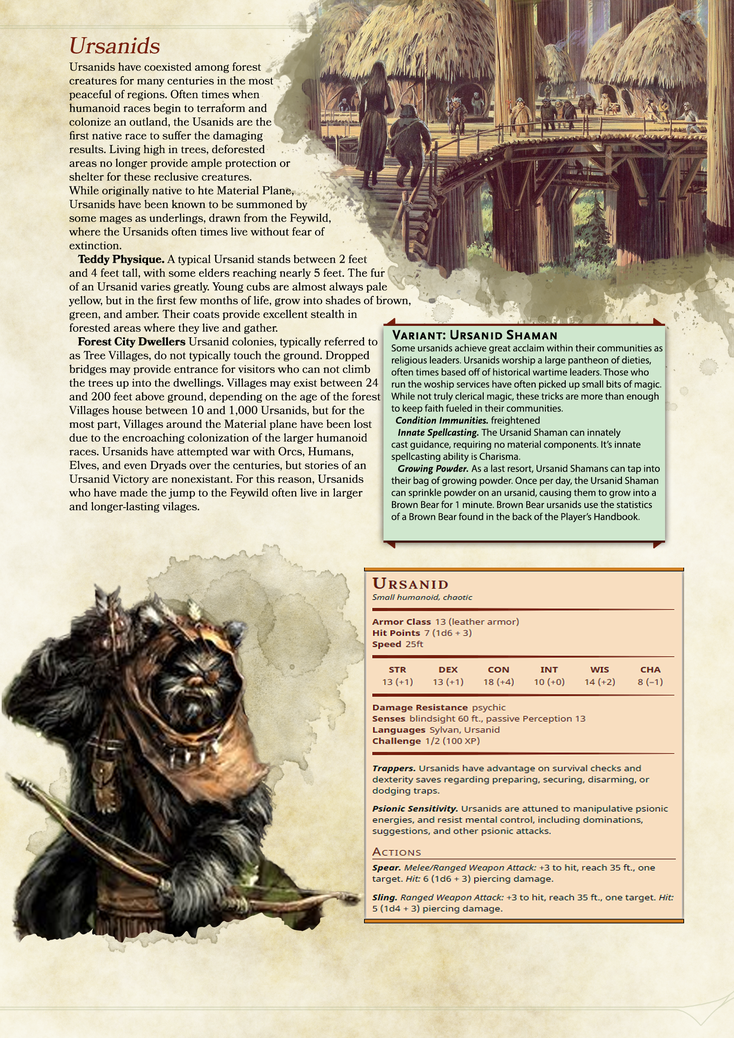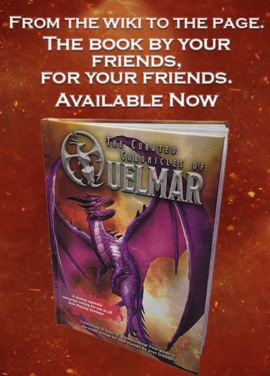
"Those furballs are pretty fearsome warriors, despite their size." - Clapperclaw’s Dying Words
Ursanids were sentient, diminutive, furry humaniods native to the forests of Kiston. They have coexisted among forest creatures for many centuries in the most peaceful regions. They were most notable for aiding and abetting Stumblebum's adventures, while he was stationed on the island back in the year 691. After the time jump Stumblebum sent his pet mouse Othello to find the ursanids, but the mouse never returned. Ursanids were curious individuals that stood about one meter tall; they were omnivorous and used spears, slings, and knives as weapons; they also, have been know to use hang gliders, battle wagons, and small mules as vehicles. Although extremely skilled in forest survival and the construction of primitive technology like gliders and catapults, the ursanids had yet to progress past stone-level technology when discovered by Stumblebum. They seemed to be quick learners, however, when exposed to more advanced technology with simple mechanical processes and concepts.
"Lives are like campfires. Some burn long, others not. My people's fires burn shorter than yours. It is biology." - Kredick, the Red to Stumblebum... on immortality
A full life cycle of an ursanid spans on average 30 years with pregnancies lasting 14 weeks and infancy lasting 18 months. An ursanid is fully adult at the age of 12.
Appearance[edit | edit source]
ursanids were a group of humanoid mammals, averaging about one meter in height, which could provide an advantage when trying to hide. They were covered in fur from head to toe, but coloration varies greatly. Almost all cubs are born a pale yellow, but in the first few months of life grow into shades of brown, green and amber. With most adults coats turning into a deep brown or black. Some had near-white or reddish fur, but red fur is supposedly the rarest shade an ursanid can get. Most ursanids had solid-colored fur, though a few sported stripes. They had large, bright eyes, small humanoid noses, and hands that possessed two fingers and an opposable thumb. Despite their small size, the ursanids were physically strong enough to overpower combat-trained humans. At the Battle of Chad, ship Captain Seaworth likened their appearance to "little bears".
Teddy Physique. The ursanids' coats along with their size provide excellent stealth in forested areas where they live and gather.
History[edit | edit source]
"Ursanids have a difficult time separating fact from myth. This may be the great strength of their society." - Brak
Despite their primitive technology and their isolation from other cultures, ursanids were not totally unknown in the wider realm of Quelmar, even before the arrival of Stumblebum on Kiston. As early as 940 BR, an ursanid mercenary named Treek became involved in the events of the Draconic Crusades.
Over the centuries, ursanids have waged land wars against, Orcs, Humans, Elves and even Dryads but stories of a ursanid victory are nonexistent. For that reason ursanids living in the fey wild have lived the most prosperously.
Tribal Structure within the Village[edit | edit source]
The tribal structure of the race is lead by a Council of Elders ruling over each individual village, headed by a chief. A medicine man also lived in each village, a keeper of mystical lore, and a healer to the injured.
The warriors of the different tribes wore raggedy garments on the head to signify the ursanid's tribe. The warriors also wore wooden chest shields, the jawbones of tiny animals, and sharp teeth. Some decorated themselves with ornaments such as feathers, necklaces, and pendants, making their body look like a clutter of trinkets.
Prominent members of the tribes carried totems to symbolize their rank. The lead warrior wore a headdress made of feathers called the "white wings of hope". The eldest son of the tribal leader's family wore a headdress called the "red wings of courage". The second son wore the "blue wings of strength".
Marriage[edit | edit source]
Unmarried male ursanids spent much of their time living alone in the forest building their own small huts near enough to the tree city to assist the village in day to day in work. Unmarried females would leave gifts of food, clothing, or weaponry on the door-steps of unmarried males as a sign of their attraction and to tell how much the village missed them and wished they would come back as part of a family and as the female's mate.
If the male decided to take a mate, he had to build a family hut in the tree city where he and his mate could live. The construction of a new hut signaled that the male had decided to take a mate, at which point all of the unmarried females would try to woo him. Until his home was finished, the male did not decide whom he was taking. The chosen female had the right to refuse the male or the hut he had built.
Very young ursanids, are sometimes strangely referred to as woklings.
Children[edit | edit source]
Ursanids were very closely attached to their fuzzy children called woklings. An entire village fawned over newborn babies. They always gave the children much attention and they considered the care of their children a shared responsibility. Woklings had few rights and the children had to learn many rituals and legends that would serve as moral guides throughout their lives. When the wokling came of age, they attended the Festival of Hoods. This festival marked the transition from wokling to ursanid.
Religion & Culture[edit | edit source]
For the forest dwellers, the surrounding giant trees played an important cultural role. These hunter-gatherers were a deeply spiritual people. They believed themselves to be descendants of the Great Tree, a sacred tree in the forests. The religion was based on nature worship. Many religious ceremonies were arranged to please various gods of weather, trees, the hunt, engineering prowess, and fertility. There were also darker spirits that symbolized the dangers of the forest. The ursanids held magnificent festivals of rain, sun, spring flowers, and fruits. There were also "Dark Rituals" involving bloody sacrifices. The rituals were held at night under the light of burning bonfires. The shamans tossed the leaves of hallucinogenic herbs into the fire that caused the ursanids to have vivid dreams.
Shamans[edit | edit source]
Some ursanids achieve great acclaim within their communities religious leaders. Ursanids worship a large pantheon of deities, often times based off of historical wartime leaders. Those who run the worship services have often picked up small bits of magic. While not truly clerical magic, these tricks are more than enough to keep faith fueled in their communities. Every village appointed its own male or female mystic or shaman. The shaman was sometimes simply the village con-artist, who made up answers about what the gods wanted and how they could be pleased. Others had genuine abilities. For the shaman's services, the village gave the shaman anything he or she may have wanted, including crystals, shells, polished skulls and other treasures the shaman found interesting. Many shamans wore large animal skulls on their heads.
Shamans were also the tribal healers, usually relying on vile-smelling herbal medicines. Many types of fungus, lichens, roots, berries, flowers, epiphytes, and bark were used, with varying medicinal effects.
Condition Immunities. frightened
Innate Spellcasting. The ursanid Shaman can innately cast guidance, requiring no material components. It's innate spell casting ability is Charisma.
Growing Powder. As a last resort, ursanid Shamans can tap into their bag of growing powder. Once per day, the ursanid Shaman can sprinkle powder on an ursanid, causing them to grow into a Brown Bear for one minute. Brown Bear ursanids use the statistics of a Brown Bear found in the back of the Players Handbook.
Soul Trees[edit | edit source]
The massive coniferous trees that filled the forest of Kiston were known as "Soul Trees" or "Life Trees". The ursanids had a deep religious connection with these trees. For every baby born, a new seedling was planted by the village. Throughout that ursanids life, he or she was linked to their totem tree. When the ursanid died, it was believed their spirit would go to live inside their own totem tree.
In times of crisis, the village shamans would attempt to contact the ancient spirits that lived within the oldest trees for advice and guidance. The shamans insisted that it was a private ritual. The ursanids never questioned the sacred advice brought back by the shamans, though they had never heard these ancient voices before.
Tree Village[edit | edit source]
Most ursanids lived high among the trees of the forest, in villages and colonies built between the closely spaced trees. The basic design of a tree village had a "Central Village" of thatched-roof huts on the primary limbs. These huts were high enough above the ground to be out of reach from predators. Usually between 24 and 200 feet high, depending on the age of the forest for the most part. Suspended bridges connected the gaps between trees, adjoining distant huts. Knotted rope ladders allowed access up or down.
Colony populations can be as small as 10 and as large as a 1000. But most pre existing colonies have been wiped out by some of the more powerful humanoids.
In most tree cities, the village Elders ordered the largest huts built directly on the trunk of the tree. These central buildings belonged to the chief of the tribe. The chief used the largest open areas for village gatherings, meetings, council fires, and storytelling ceremonies. Family groups kept their own dwellings in clusters on the outlying trees. Separate huts were also built for unmarried females, elders, and visitors. A sealed building was also created higher than the rest of the tree city and was used as the communities' food storage.
Some eschewed village life for a nomadic existence. More traditional ursanids came to refer to them as Jindas, after the nomadic tribe of Jindas that lived on Kiston
Ground Village[edit | edit source]
A small town of ground huts built around and under the tree village.
Some ursanids also at one time lived in isolated huts on the forest floor. They eventually moved backin to the trees, however, because the ground villages left them open to attacks by predators. It is worth noting that in the First Battle of Stumblebum and the Gorax (circa 691 PR) The entire ground village had been destroyed by the Gorax's fierce attacks and by a spreading fire that broke out in the turmoil.
Lake Village[edit | edit source]
A few ursanids also built homes on shallow, placid lakes. The y built their villages on stilts out in the water. The surrounding water protected them from large predators. They got most of their food by setting wicker traps to catch fish in the lake. The elders spent their time harvesting marsh grasses and drying them in the sun. They then took these dry grasses and made them into mats, clothing, baskets, and decorative tapestries. The young loved to splash in the water and dig in the mud for buried shellfish. A series of pipes and hollow stumps were constructed to channel water from the lake into the ground village and up into the tree village. Those in the lake were left with the task of maintaining this pipeline.
The destruction of this waterway is some of the only information we have currently about what happened to the ursanids of Kiston.
These ursanids also built wooden sail boats and oars.
Cliff Village[edit | edit source]
Some tribes made their homes on a rock face beside a spraying waterfall. Engineers created an intricate set of waterwheels, driven by the force of the waterfall. These waterwheels drove large wooden gears that rotated grindstones, operated conveyor belts from one side of the village to the other, and ran a set of wooden elevator platforms that moved up and down the cliff.
Culture[edit | edit source]
Ursanids ritually dance around a bonfire.
"They tend to poke spears in your direction, but don't panic—it's their way of showing interest."
― Brak
Music[edit | edit source]
The ursanids enjoyed singing and playing music during celebrations, festivals, and rituals. They also believed that music enhanced their work. They were resourceful and tended to make use of everything they could get their hands on, so they used a variety of drums, horns, flutes, and other simple instruments in their music.
Language[edit | edit source]
The ursanid language was known as Ursanees.
Hunting and Trapping[edit | edit source]
"We ursanid hunt only when there is no other food." - Paploo
Ursanids ventured to the forest floor to hunt, using stone-tipped arrows and spears as well as elaborate traps to catch their prey. They considered themselves to be great hunters.
A single hunter could snare small animals but an entire ursanid hunting party could catch animals as large as a boar-wolf. They had created effective ways to hunt these monstrous animals using spears and poison darts. The Ewoks first set up a trap with scraps of bloody meat from a previous hunt and then they would set a vine net on the forest floor. When the wolf ran towards the meat, it would get caught in the net. Then, from the underbrush, the warriors charged at the trapped wolf. One of these boar-wolves would provide enough meat to feed a village for days.
Smaller game was killed with small sling nets. When a creature stepped into a loop it set off a pressure trap. A pinned sapling would break free and fling the animal into the nearest tree.
Tek swee was a trap translated into Common as "head hitter". This trap was a common defense against the Gorax. When a Gorax attempted to raid a village, the warriors would let loose a massive log roped onto trees. The log would swing into the Gorax like a giant battering ram.
Recreation[edit | edit source]
The "Tribal Games" were a series of games that ursanids from scattered tribes came to play. There was much dancing and storytelling, but there were also far more dangerous events. Tree-jumping was a very popular game among younger ursanids. They would climb to the highest lifetree and leap off the highest limb. They had to catch themselves on the lower limbs until they descended all the way to the ground. If an ursanid missed, he could be seriously injured, some resulted in death.
Ursanids were sometimes known to smoke combustible substances, namely mushroom powder, in pipes, for recreational or spiritual purposes.
Festivals[edit | edit source]
Throughout the year, ursanids hold extravagant festivals of the rain, the sun, springtime flowers, fruits and love. These involve tribe and family groups coming together to feast, sing, dance and generally have a good time. They also have certain 'Dark Rituals' involving bloody sacrifices. These are held at night under the light of smoky bonfires, into which the shamans toss the leaves of hallucinogenic herbs (dream mist), to cause the ursanids to have vivid dreams. Hallowe'en, where the ursanids would dress up as ghosts, was generally considered by them to be the best celebration of the year.
Weapons and equipment[edit | edit source]
"Though they show no scientific skills of their own, they [the ursanids] are inquisitive about technology, occasionally to their detriment." - Stumblebum
The ursanids used a variety of weapons that included knives, stone spears, slingshots, bow and arrows.
Their arrows were also tipped with a potent neurotoxin, ensuring that anyone who was shot by them would die in an extremely gruesome manner; even seeming minor wounds would result in the victim clawing off any headgear (if wearing any) and gasping for air, the neurotoxin paralyzing every single muscle in the victim's body, including their lungs.
Aside from the above mentioned traps, they also utilized a pittrap that they often lured their enemies into by running away and thustriggering the traps to have them impaled by stakes fixed to the ground.
They also often held down their enemy, removed their helmets (if wearing them) and proceeded to bludgeon them with stone axes and knives made of volcanic glass.
Suspected Extinction[edit | edit source]
Little is known of where the ursanids of Kiston have disappeared to as of 791 PR. But it is assumed that they have gone extinct, at least the tribes that were there before Stumblebum was thrown into the future. Perhaps they are simply in hiding deep within the woods of Kiston, or perhaps they were slaughtered in some sort of war.
Resurgence and the Wand of Ursling[edit | edit source]
"We can safely ignore these contemptible little fur-balls." - Clapperclaw... at the beginning of the Battle of Chad
Stumblebum has recently found the Wand of Ursling which strangely and mystifyingly appears to manifest members of the species one at a time. Little is known about its magical abilities either.

